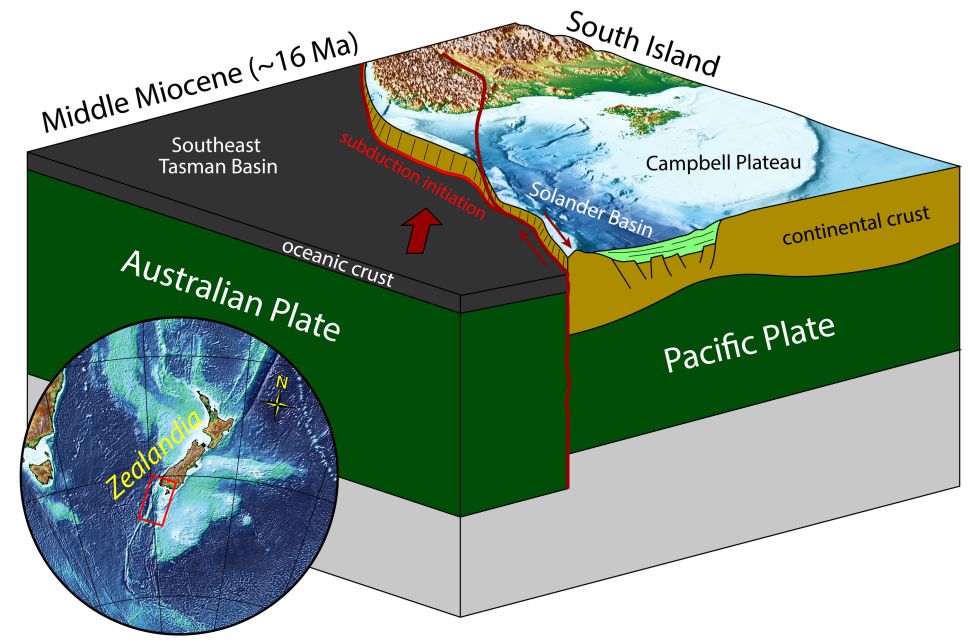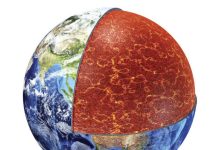
South of New Zealand in the Tasman Sea is a stretch of stormy ocean where the waves regularly swell 20 feet (6 meters) or more and the winds blow at 30 mph (48 km/h) on a good day. Deep below these stormy seas, Earth is unquiet, too.
This region is home to the Puysegur Trench, site of one of the youngest subduction zones on the planet. Here, the Australian plate is shoved under the Pacific plate, creating frequent large earthquakes, including a 7.2-magnitude quake in 2004.
Now, new research reveals how this baby subduction zone came to be: Over millions of years, a bit of the “hidden” continent of Zealandia on the boundary between the Australian and Pacific plates, got stretched and shifted in a way that led the denser oceanic crust to slam into — and under — it.
This finding that positioning different types of crust against one another at a preexisting plate boundary leads to subduction may help to explain how other new subduction zones around the world form.
Related: 3 large earthquakes hit off New Zealand within hours…
“Subduction zones are one of the most important, if not the most important, plate boundaries,” said study lead author Brandon Shuck, a doctoral candidate at The University of Texas at Austin. “They’re really the main drivers of plate tectonics, so they’re the primary reason why the plates on Earth actually move. And also they’re very destructive plate boundaries. …We don’t really understand well how they start out and how they form in the first place.”
Little geological history behind to study
Subduction zone formation is mysterious because subduction zones are, by nature, destructive. When a plate of oceanic crust dives under continental crust, the rocks at the surface twist, break and deform. The oceanic slab, meanwhile, churns into the mantle, where it’s melted beyond recognition. This leaves little geological history behind to study.
The subduction zone in the Puysegur margin is young enough that this history has not yet been erased. That makes it an ideal spot to answer the question of how subduction zones form in the first place. There’s not yet any good explanation of how tectonic plates break open and start subducting.
Related: Rare triple tsunami off New Zealand…
Studying the Puysegur margin is no easy feat, though, because it’s in the “Roaring Forties,” the latitudes between 40 degrees south and 50 degrees south where the winds and currents are brutal. Scientists aboard the research vessel Marcus Langseth set out to this region in 2018 as part of the South Island Subduction Initiation Experiment. It was a challenging trip, Shuck said. The crew had to spend almost a quarter of the time sheltering behind islands to avoid gales.
“Our boat was rolling side to side by like 20 degrees at one point,” Shuck said. “It was a mess.”
In spite of the weather, the researchers were able to deploy seafloor seismometers and to take seismic surveys of the subsurface, a method which uses reflected sound waves to see underground structures.
How did the subduction zone form?
The new data allowed the researchers to put together a history of the young subduction zone, which Shuck presented at the virtual meeting of the Seismological Society of America on April 22.
It all started about 45 million years ago, when a new plate boundary between the Australian and Pacific plates began to form because of a force called extension — basically, tectonic forces pulled the two plates apart like putty.
The oceanic crust at the plate boundary responded to this extension predictably: As the crust thin, magma from the mantle pushed up through fractures, hardening into new rock. This process is called seafloor spreading, and it’s how new oceanic crust forms.
But there was a catch: The secret continent of Zealandia. Zealandia is a submerged section of continental crust the size of Australia around New Zealand. Zealandia was perched over the north end of this extensional zone. As continental crust is thicker and more buoyant, the extensional forces working at the plate boundary couldn’t crack Zealandia. Instead, the continental crust merely stretched as it spread, creating a thinned-out zone now known as the Solander basin.
Now there were two plates. The Australian Plate, to the west, consisted of continental crust from Zealandia in the north and new oceanic crust in the south. The Pacific Plate, to the east, also consisted of oceanic crust in the south. To the north, the Pacific Plate hosted the thinned-out continental crust of the Solander basin. At the plate boundary, oceanic crust bumped up against oceanic crust, and continental crust against continental crust.
Likely little of interest would have happened, if not for another tectonic shift 25 million years ago.
At that time, the Australian-Pacific plate boundary stopped pulling apart. Instead, the plates started to move past each other, creating what’s known as a strike-slip fault. Now, the Pacific plate was moving south, and the Australian plate was moving north. This opposing movement brought the oceanic crust of the Australian plate right next door to the thin Solander basin continental crust on the Pacific plate.
This was the key to starting subduction, Shuck said: Continental crust is more buoyant than denser oceanic crust, and this difference in buoyancy allowed the denser part of the Australian plate to slide under the lighter Pacific one, especially because the boundary between these continental and oceanic plates was already weakened by the earlier strike-slip faulting. The findings drive home how important strike-slip movement is to tectonics, Shuck said.
“How plates rotate is really important,” he said. “If you just think about pulling things apart and pushing them together you don’t really create that much contrast, but [with] strike-slip, you’re translating [sliding a portion of crust] and it’s super-efficient. Just imagine, with the plates sliding past each other, you’re going to cause materials of different properties to come together eventually.”
What about other subduction faults?
There are other spots around the globe where strike-slip movement is happening in the same place as the compression and convergence of plates, particularly along the Queen Charlotte fault north of Vancouver and south of Alaska, Shuck said. That fault may be a place where a subduction zone could potentially form, he said.
Will the fault at Macquarie Ridge begin to turn into a subduction zone, too?
The Puysegur margin and Macquarie Ridge are related and are experiencing similar changes in plate motion over time, though Puysegur is further along in the process.
Macquarie Ridge, being two slabs of oceanic crust coming together, might be more resistant to subduction than the continental crust and oceanic crust boundary at Puysegur. But subduction zones can also spread along a fault from a single point. Those two segments could actually link up — maybe — in the future.
Meanwhile, scientists are looking to learn more about the mysterious seabeds across Earth’s five oceans… Maybe these new maps will help them find new dangerous subduction zones at the bottom of our seas… Let’s wait a bit ;-)… [Live Science]
Now subscribe to this blog to get more amazing news curated just for you right in your inbox on a daily basis (here an example of our new newsletter).
You can also follow us on Facebook and/ or Twitter. And, by the way you can also make a donation through Paypal. Thank you!
You should really subscribe to QFiles. You will get very interesting information about strange events around the world.













New continent THAT IS TOTALLY UNDERWATER ~ WOW THAT WILL CHANGE LIFE AS WE KNOW IT FOR SURE eye roll!
Hmmm,
Rumor has it that the satanic elites have property in that area. All those piles of gold will be sinking like quicksand. What a pity. ?
New Zealand—underground bunkers—well, not just a hole in the ground but you should be so priveleged to own the structures above ground they have underground ! I wonder how their supply of adrenachrome is—-
I read that the satanic elitists pay women to get pregnant, and use the babies in rituals.
They own houses, or wings of houses dedicated to supplying them.
I thought about it, and it does seem plausible. No records. No paper trail.